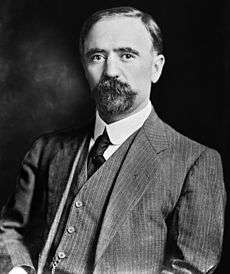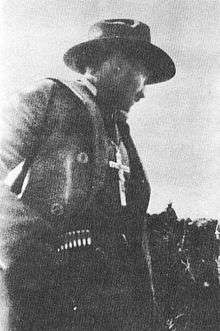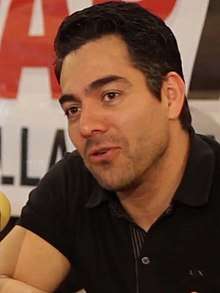Northern Mexico

Northern Mexico (Spanish: el Norte de México), commonly referred as El Norte, is an informal term for the northern cultural and geographical area in Mexico. Depending on the source, it contains some or all of the states of Baja California, Baja California Sur, Chihuahua, Coahuila, Durango, Nuevo León, Sinaloa, Sonora and Tamaulipas.
In fact there is not a border that separates the northern states from the southern states in Mexico. For some authors, only states that have a border with the US are considered as northern Mexico, i.e. Baja California, Chihuahua, Coahuila, Nuevo León, Sonora and Tamaulipas.[1] Others also include Durango, Sinaloa and Baja California Sur.[2] Other people consider that the north starts above the Tropic of Cancer,[3] but this description would include some parts of Zacatecas and San Luis Potosí that are usually not considered northern states.
History
Before colonization
It is not known exactly when the first settlers came to Northern Mexico. The bad weather in the region limited the practice of agriculture, so ancient cultures developed a nomadic lifestyle dedicated to hunting and gathering.[4]
One of the most important native cultures at northern Mexico are the Tepehuanes in Durango, who are actually named the Odamis, meaning "people from the mountains".[5] Something similar has happened with the Raramuris in Chihuahua; Raramuri means "people who run", but they are known as Tarahumaras. Other important cultures are Mayos and Yaquis in Sonora, and Laguneros in Coahuila. In Nuevo Leon, many nomads were exterminated for resisting the construction of Monterrey.[6]
Colonial era
The first city of the region was Durango, founded by Francisco de Ibarra, a Basque explorer. During the colonial era, Durango, Chihuahua and some parts of Sinaloa and Coahuila were a Basque colony named the Nueva Vizcaya. Now, most Duranguenses are Basque descendants.[7] Other important cities like Monterrey were founded almost 50 years later.
States
| Baja California | Baja California Sur | Chihuahua |
 |
 |
 |
| Mexicali | La Paz | Chihuahua |
| Coahuila | Durango | Nuevo León |
 |
 |
 |
| Saltillo | Durango | Monterrey |
| Sinaloa | Sonora | Tamaulipas |
 |
 |
 |
| Culiacán | Hermosillo | Ciudad Victoria |
Culture
Northern Mexican culture is very different from the culture in south and central Mexico. Northern Mexican opinion tends to be more conservative on average on cultural topics like abortion, gay marriage and legalization of marijuana,[8] but more liberal on topics like business or technology.[9] Another important difference between the North and the rest of Mexico is that Northern Mexicans tend to be more identified with their Spanish heritage.[10]
In early 2014, the Strategic Communication Cabinet, a statistical consulting services company, published a report called "Social Intolerance In Mexico",[11] in which polls that covered several social issues were conducted in the 45 largest cities and municipalities of the country. Aside from liberal Mexico City, the federal capital, the study found the strongest support for same-sex marriage in northern cities such as Tijuana and La Paz; whereas it was the weakest in Durango, Ciudad Victoria, Chihuahua and Monterrey. As for adoption by same-sex couples, it was more widely accepted in the border cities of Tijuana and Ciudad Juárez, while the least support was found in Chihuahua and Durango. Support for abortion upon request, cannabis legalisation and euthanasia was the weakest in Northern Mexico. Nonetheless, Coahuila became the first state to legalise same-sex marriage in the country.[12]
Festivities
For a long time, November 20; the anniversary of the Mexican Revolution; was considered the National Day in northern states. This has been changed by some politics implanted by the SEP making obligatory the celebrations of the September 16 (The Independence Day of Mexico) and the Día de los Muertos, which are days that originally weren't celebrated in the region.[13]
Other important days in the north are July 8, the foundation of Durango City (the first city founded in the North) and the carnaval of Mazatlán, celebrated 6 days before Ash Wednesday. Because of the American influence in the region, northern Mexicans also celebrate some American traditions like Halloween, Thanksgiving and Saint Patrick's Day.
Gastronomy
As well as the Spanish and the indigenous people, Northern Mexico has received Lebanese, Jewish, Portuguese, Chinese, Irish, German and Italian immigrants. All this mixture of cultures have strongly influenced the gastronomy from the north. Northern Mexican gastronomy is based in beef, goat and pig meat and flour tortillas[14] which are remnants of Jewish and Lebanese heritage. Because of the German influence cheese and dairy products are also important in the gastronomy of the region. Quesadillas and burritos are probably the two most famous dishes from the north. One of the most famous customs from northern Mexico is to reunite family and friends on weekends to prepare barbecue, named Carne Asada by the Mexicans. A variation of this tradition is to prepare discada, a mixture of grilled meats cooked on an agricultural plow disk harrow.
Sports
.jpg)
Association football, or soccer, is one of the region's most popular sports,[17] as it hosts four out of the eighteen teams that currently play in the Liga MX, the country's top division of the domestic football league system. Major cities are home to these teams such as Monterrey and Tigres UANL, both based in Monterrey, Santos Laguna in Torreón and Tijuana in the border city of the same name. Notably, Northern teams have dominated the Liga MX in the 2010s, winning a combined total of nine titles and reaching more than half of the decade's finals.[18][19][20] Moreover, Northern teams that play in the Ascenso MX, the second professional level of the domestic football system, include: Juárez, based in the homonymous border city, Dorados de Sinaloa from Culiacán, Cimarrones de Sonora in Hermosillo, Tampico Madero and Correcaminos UAT, both based in the state of Tamaulipas.
Baseball is another popular sport in Northern Mexico,[21] particularly in states such as Sinaloa and Sonora.[22][23] Seven of the sixteen teams of the Triple-A Mexican League are based in the North. The independent Mexican Pacific League (Liga Mexicana del Pacífico or LMP) is based in the North, with most of its eight teams playing in Northwestern Mexico. The LMP is a winter league, its season coinciding with the Major League Baseball (MLB) off-season; MLB players can therefore participate, making MPL more competitive. Since the 1970s, the winner of the Mexican Pacific League has competed in the prestigious Caribbean Series, won nine times by Mexican teams, primarily in the 21st century, such as Yaquis de Obregón and Naranjeros de Hermosillo, based in the state of Sonora, Venados de Mazatlán and Tomateros de Culiacán, both based in the state of Sinaloa.[24] As for the Mexican Baseball League, the country's oldest running professional league, which runs in the summer season, several Northern teams participate such as Sultanes de Monterrey, Saraperos de Saltillo, Acereros de Monclova, Algodoneros de Unión Laguna, Generales de Durango, Tecolotes de los Dos Laredos and Toros de Tijuana. By far, Sultanes de Monterrey has been the most successful Northern team in the Mexican League, winning nine titles.[25][26] Moreover, there are several minor state-wide baseball leagues in the region such as Liga Estatal de Béisbol de Chihuahua, Liga Mayor de Béisbol de La Laguna and Liga Norte de México.
Another popular sport is basketball, played at the professional level throughout the entire year between the National Basketball League, founded in 2000, and the Pacific Coast Circuit, which exclusively involves teams based in Northwestern Mexico. The Liga de Básquetbol Estatal de Chihuahua is a minor league played primarily by local teams in the border state of Chihuahua. Remarkably, Chihuahua-born Eduardo Nájera became the second Mexican to play in the National Basketball Association (NBA), after Sinaloa-born Horacio Llamas. As for American football, National Football League (NFL) following is popular in several northern cities, particularly amongst the middle and upper classes.[27][28] Notably, Torreón-born kicker Raúl Allegre played for several NFL teams throughout his career in the 1980s. Boxing is one of the most popular sports in the country and Northern Mexico has long been a source of world famous players such as Julio César Chávez, Oscar de la Hoya and Misael Rodríguez.
Notable people
- Guadalupe Victoria, first president of Mexico
.jpg) Venustiano Carranza, the president that promulgated the constitution of Mexico
Venustiano Carranza, the president that promulgated the constitution of Mexico Santiago Vidaurri, liberal politician and ideologist from the northern Mexico separatism
Santiago Vidaurri, liberal politician and ideologist from the northern Mexico separatism Francisco Villa, the most notable general in the Mexican Revolution
Francisco Villa, the most notable general in the Mexican Revolution Francisco I. Madero, starter of Mexican Revolution
Francisco I. Madero, starter of Mexican Revolution Enrique Gorostieta, general of Mexican Revolution and in the Cristero War
Enrique Gorostieta, general of Mexican Revolution and in the Cristero War María Félix, actress
María Félix, actress Dolores del Río, actress
Dolores del Río, actress- Anthony Quinn, actor
 Julio César Chávez, considered one of the greatest boxers of all times
Julio César Chávez, considered one of the greatest boxers of all times
 Adal Ramones, comedian
Adal Ramones, comedian Eduardo Najera, former NBA player
Eduardo Najera, former NBA player Aracely Arámbula, actress
Aracely Arámbula, actress Omar Chaparro, comedian and actor
Omar Chaparro, comedian and actor Jared Borgetti, second all time scorer from the Mexican national soccer team
Jared Borgetti, second all time scorer from the Mexican national soccer team Jaime Rodríguez Calderón "El Bronco", governor of Nuevo León and candidate in the 2018 presidential election
Jaime Rodríguez Calderón "El Bronco", governor of Nuevo León and candidate in the 2018 presidential election Rosario Espinoza, three time Olympic medal winner
Rosario Espinoza, three time Olympic medal winner
References
| Wikivoyage has a travel guide for Northern Mexico. |
- ↑ Mize, Ronald L.; Swords, Alicia C. S. (2010). Consuming Mexican Labor: From the Bracero Program to NAFTA. University of Toronto Press. p. 175. ISBN 9781442601581.
- ↑ Burian, Edward (2015-08-15). The Architecture and Cities of Northern Mexico from Independence to the Present. University of Texas Press. ISBN 9780292771901.
- ↑ Hobbs, Joseph J. (2008-03-13). World Regional Geography. Cengage Learning. p. 506. ISBN 0495389501.
- ↑ http://portalacademico.cch.unam.mx/materiales/prof/matdidac/sitpro/hist/mex/mex1/HMI/Aridoamerica.pdf
- ↑ http://pueblosoriginarios.com/norte/suroeste/odami/odami.html
- ↑ http://www.elclima.com.mx/historia_y_fundacion_de_monterrey.htm
- ↑ https://www.elsiglodetorreon.com.mx/noticia/595895.siglos-de-historia.html
- ↑ https://distintaslatitudes.net/durango-en-busqueda-del-matrimonio-igualitario
- ↑ https://archive.is/20121219231343/elojodemexico.blogspot.mx/2009/07/la-cultura-del-norte-de-mexico-mexicali.html
- ↑ http://chihuahuasi.blogspot.com/2012/06/caracteristicas-de-los-chihuahuenses.html
- ↑ Gabinete de Comunicación Estratégica (2014). "Intolerancia Social en México" (PDF) (in Spanish). Retrieved 12 August 2018.
- ↑ "Mexican state of Coahuila approves same-sex marriage". BBC. 2 September 2014. Retrieved 12 August 2018.
- ↑ https://es.quora.com/Se-celebra-el-D%C3%ADa-de-Muertos-en-el-norte-de-M%C3%A9xico
- ↑ http://foodandtravel.mx/platillos-tipicos-de-torreon/
- ↑ Gonzalez, Roger (14 June 2018). "World Cup 2026: What are the host cities in USA, Mexico and Canada going to be?". CBS Sports. Retrieved 12 August 2018.
- ↑ Carlisle, Jeff (13 June 2018). "Which venues could host games for 2026 World Cup held in U.S., Mexico and Canada?". ESPN. Retrieved 12 August 2018.
- ↑ Mathaler, Jon (28 July 2018). "Soccer Insider: Liga MX teams make inroads into U.S. television markets". Star Tribune. Retrieved 12 August 2018.
- ↑ Juárez, César (3 December 2017). "El norte manda: Sus equipos han llegado a 7 de las 10 últimas finales" (in Spanish). Diario AS. Retrieved 12 August 2018.
- ↑ Rosales, Jorge (14 May 2018). "¡El Norte manda! Por octava vez al hilo, equipo norteño busca título de Liga MX" (in Spanish). Medio Tiempo. Retrieved 12 August 2018.
- ↑ Patiño, Lenin (21 May 2018). "Los equipos del norte siguen mandando en la Liga MX" (in Spanish). Milenio. Retrieved 12 August 2018.
- ↑ Sánchez, Jorge (2 February 2018). "Baseball revival happening in Mexico". MLB. Retrieved 12 August 2018.
- ↑ Cervantes, Héctor (2 December 2018). "Sinaloa es quien más nutre al beisbol mexicano" (in Spanish). El Debate. Retrieved 12 August 2018.
- ↑ López, Tess (29 November 2017). "Sonora, pasión por el beisbol en las venas" (in Spanish). El Debate. Retrieved 12 August 2018.
- ↑ Padilla Márquez, Josué (1 February 2018). "Los campeones mexicanos en la Serie del Caribe" (in Spanish). Milenio. Retrieved 12 August 2018.
- ↑ La Afición (20 February 2017). "Los nueve títulos de los Sultanes de Monterrey" (in Spanish). Milenio. Retrieved 12 August 2018.
- ↑ "Después de 11 años, Sultanes vuelve a ser el rey en LMB" (in Spanish). Medio Tiempo. 15 December 2017. Retrieved 12 August 2018.
- ↑ Tucker, Duncan (17 November 2016). "'An upper-class picnic': the Mexican elite's curious love affair with NFL". The Guardian. Retrieved 12 August 2018.
- ↑ Weinfuss, Josh (17 November 2016). "From youth to pro, American football has taken root in Mexico". ESPN. Retrieved 12 August 2018.